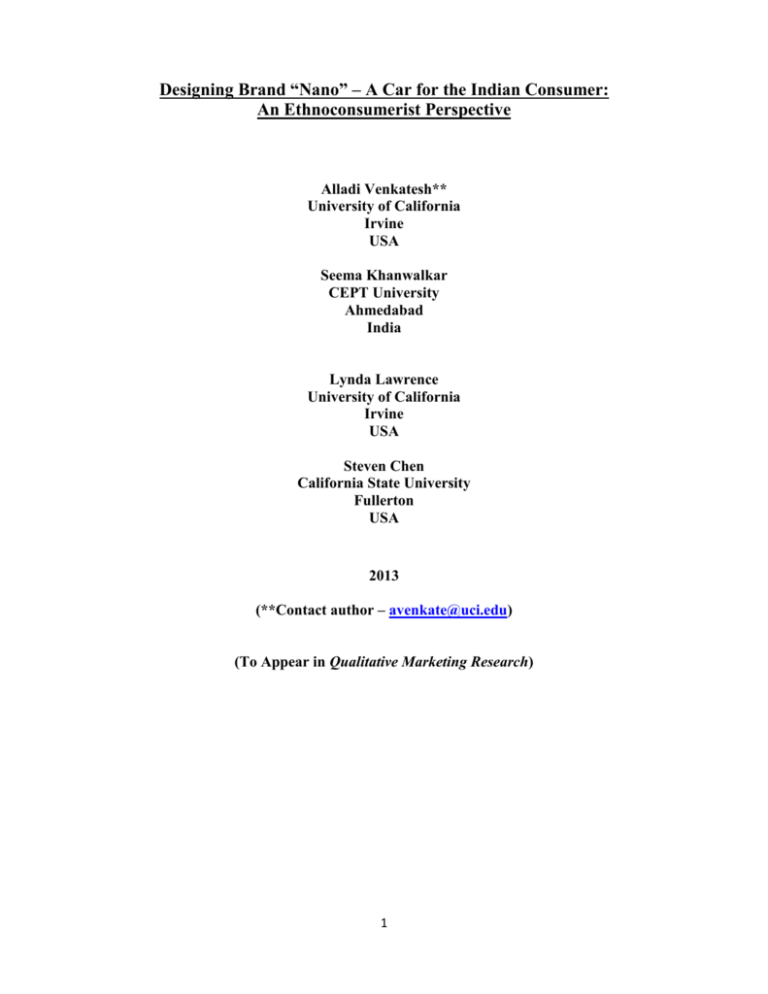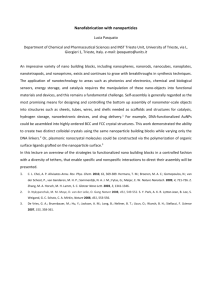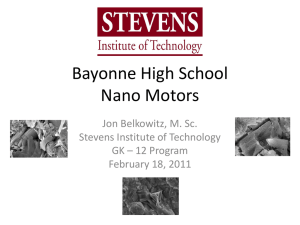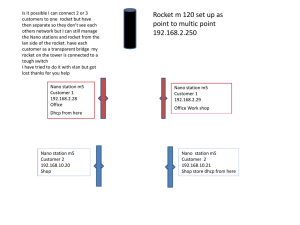Designing *Nano* * A Car for the Indian Consumer
advertisement

Designing Brand “Nano” – A Car for the Indian Consumer: An Ethnoconsumerist Perspective Alladi Venkatesh** University of California Irvine USA Seema Khanwalkar CEPT University Ahmedabad India Lynda Lawrence University of California Irvine USA Steven Chen California State University Fullerton USA 2013 (**Contact author – avenkate@uci.edu) (To Appear in Qualitative Marketing Research) 1 Designing Brand “Nano” – A Car for the Indian Consumer: An Ethnoconsumerist Perspective Abstract In this paper, we present the design and branding considerations pertaining to “people’s car” or “Nano” which is an affordable car targeted to the Indian consumer. The question we pose in this paper is what are the consumer issues and branding/design considerations that have gone into the development of Nano? We examine this question from an ethnocousumerist perspective. 2 Designing Brand “Nano” – A Car for the Indian Consumer: An Ethnoconsumerist Perspective Introduction In this paper, we present consumer issues and branding/design considerations pertaining to “people’s car” or “Nano” (Figure 1) which is billed as an affordable passenger vehicle designed for the Indian consumer for driving in the Indian setting. Recently, there has been a lot of publicity given to the introduction of Nano in the local and international press (Automotive News 2008, Bhanot 2008, Tata Motors 2008, Kurczewski, 2009, Chacko, Noronha and Aggarwal 2010). It has now been put on display in Cooper-Hewitt Design Museum and given a celebrity status for its innovative design (Patton 2010). In this context, we have seen much recent work on branding issues in the Asian context (Cayla and Eckhardt 2008) which are relevant to our study. Figure 1 (Nano Car) In general, automobiles are mostly designed in highly industrialized and developed economies although manufacturing plants exist all over the world. Automobiles are complex technologies and it has not been possible for less advanced countries to design their own versions of an automobile although they have manufacturing facilities for some premier brands. This is bound to change in the future as these countries catch up on auto design. It is in this context that we present research ideas and design considerations 3 concerning Nano – which is billed as a people’s car for the Indian market – totally designed and manufactured in India (Chacko, Noronha and Aggarwal 2010). The central question we pose in this paper is the following: what are the consumer and design issues that have gone into the development of Nano which is a low priced automobile targeted toward the Indian consumer in the middle to lower middle income group and in urban and semi-urban settings? We provide a cultural interpretation of this design initiative and its execution. Thus the main issue is, what is the cultural model that has gone into Nano brand and what are the ingredients of the cultural model? How has this taken into consideration the “Indian consumer point of view” (Bijapurkar 2008, Srinivas 2008, Varman and Belk 2009) and changing Indian economic and cultural geography (Sen 2003, Shumer-Smith 2000)? In pursuing these issues, we use an ethnoconsumerist framework (Meamber and Venkatesh 2000) together with cultural and emotional aspects of design (Norman 2004, Sparke 2004) for our study. Although the eventual success of the car in the market place and its performance as a successful innovation can be debated, this paper does not address those specific issues except to say that many well informed sources believe that it should succeed (Chacko, Noronha and Aggarwal 2010). Our focus is to examine Nano as a people’s car, the cultural underpinnings of its design and its position within the consumer context. The data for this study were gathered primarily from research publications, and public sources and press clippings. In addition, inputs were received from a designer with intimate knowledge of Nano. Conceptual Framework - Ethnoconsumerism Perspective 4 We use an ethnoconsumerist approach to this study. Ethnoconsumerism is a methodology for doing cross-cultural research (Venkatesh 1995, Meamber and Venkatesh 2000). It encourages the researcher to study culture not merely as providing the context for the study of consumer behavior but to study consumption itself as culturally constituted behavior. In principle, the ethnoconsumerist perspective goes beyond the distinction of emic and etic research approaches. The etic approach encourages the researcher to interpret phenomena from her/his point of view. On the other hand, the emic approach directs the researcher to examine the same phenomena from the subject’s point of view. Ethnoconsumerism advocates the next critical step, which is to then develop knowledge from the overall culture’s point of view. Thus the research incorporates a view of the culture informed by the culture itself as demonstrated by its text view and field view (Meamber and Venkatesh 2000). In this paper, we look at the design of Nano from the Indian cultural standpoint. We examine the Nano playing field from macro to micro, from historical to contemporary, from luxury to necessity, from expensive to affordable, from a twowheeler to four-wheeler social transformation, and from the point of view of Indian value system. Background Tata Motors: Manufacturers of Nano Tata motors is a family of pioneering industrialists whose origins can be traced to the mid-to-late 19th century beginning with shipping interests under the British colonial system followed by a more than a century of major investments into steel plants, commercial vehicles and consumer products (Mukherjee 2009). It is considered a mega economic empire. Tatas are also local representatives of Mercedes, a German auto 5 manufacturer, and Tata Mercedes is a large manufacturing company of commercial vehicles under German collaboration. Tatas are known for their philanthropy, and are founders of world class educational and advanced scientific institutes. They are one of the most trusted if not the most trusted conglomerate in India and their reputation is legendary. Thus Nano’s initial reputation as a trusted brand would remain intact. Product Offering and Brand Positioning Tata Motors announced the commercial launch of the Nano in 2008, the low-cost compact model powered by a 2-cylinder engine (see Figure 1 above). It was introduced into the local Indian market from June of 2009 (Kurczewski, 2009), and as shown in Figure 2, personally presented to the first buyer family by the CEO of Tata Motors. Figure 2 First Tata Nano delivered to proud Indian family by the Chairman of Tata Motors With a length of just 10 feet, width and height of about 5 feet, the Tata Nano has the smallest exterior footprint for a car in India. Nano is 20% smaller than the cheapest car on the Indian roads right now, the Maruti Suzuki 800. It nevertheless offers a spacious passenger compartment which can seat four adults and offers a high seating position. Its small size coupled with a turning radius of just 4 meters, makes it extremely maneuverable. 6 Tata motors planned to make 250,000 initially and expected eventually to sell 1 million annually (The Hindu 2009). The Indian auto market is very vibrant, as economic growth lifts incomes and wealth in the country. Ford, Nissan, Fiat, Suzuki, Renault were all planning to increase production in the Nano space over the next few years. Indian economy is expected to market 10 million additional cars on Indian roads in five years. Nano is designed and being marketed as a first car for the working middle class although it is conceivable it may be purchased by higher income groups as a second or third car in the family. It is targeted toward the consumers who own two-wheelers and expect to buy an automobile. The two-wheeler industry in India has grown rapidly in the country since the announcement of the process of economic liberalization in 1991. Current Indian Transportation Scene: Traffic Conditions – Design Implications In general, the traffic conditions in Indian city roads can be crowded and may appear a bit chaotic. With so many different vehicles using the same roads, from big trucks, to passenger buses, to luxury automobiles to two wheelers, the traffic congestion is a more a rule than an exception ( Figure 3). Figure 3 – A Typical Traffic Scene in Urban India 7 Under these conditions, the design and introduction of Nano is both a marketing decision and an emotional decision. It is a marketing decision because there is a demand for an affordable small car among the middle class households and an emotional decision because it taps into the national pride. The semiotics of car design and marketing touches on various aspects of Indian social, cultural and emotional life. The whole enterprise is reminiscent of the introduction of Model-T Ford in the bygone era. From Public Transportation to Private Vehicle Many Indians travel in crowded public transportation. The spatial distance between passengers is very small in these congested environments. It is not uncommon to designate gender based spaces so males and females may not sit together. This gives some relief to females in crowded interiors. But this does not solve the problem completely because there are always more passengers than seats and people have to stand in crowded buses and commuter trains. However, Nano addresses this issue by designing a privately owned affordable vehicle. Interior Space and Nano Design: From Two Wheelers to an Automobile - First Time Car Ownership In terms of Nano design, the problem of space is addressed in the following way. Since it is not a public transportation but a private vehicle, there is no issue of traveling in the company of strangers. Second, although the space in the Nano car is not luxurious, it is comfortable and better compared to the alternative i.e. public transportation or riding a two-wheeler with other family members. That is, the most common vehicle for most Indians is a two-wheeler and it’s not uncommon to see a family of three or four riding a motorized scooter or a motor bike (see Figure 4). In terms of macro conditions, we note that more than 40% of the Indian population would be in this socio-economic category 8 (Bijapurkar 2008). Thus Nano provides an affordable and safer alternative for millions of those first time buyers who want to experience car ownership for the first time. Figure 4: Two Wheelers as Family Vehicles Of course, many working professionals male and female-- do drive fancy automobiles (see Figure 5). They are not the intended target market for the Nano car. In sum, the design and conceptualization of Nano car was a major coup in the consumer context. Although modest in size, price and performance have captured the imagination of many Indians as well as foreign observers. The automobile as a passenger vehicle is a luxury for a majority of the Indian population but is potentially within their reach. 9 Figure 5 Driving among Professional and Upper Income Class Discourses of New India – The Emerging Consumer Society and National Pride: An Ethnoconsumerist Perspective Colonial Past and New Indian Pride Although India gained freedom over sixty years ago, it has taken a while to give up its colonial mentality. In the last twenty years, one of the major psycho/social/cultural developments has to do with the rising Indian pride. This is particularly true of younger generation (especially those under 30 years) whose sense of pride and achievement has lain to rest all residual colonial obsessions and negatives (Varma 2006, Bijapurkar 2008). Removed from the experiences and memories of older generation, they are hardly conscious of their colonial past nor do they seem to care. In fact, ironically, most Indians of their generation and even many segments of the semi-urban and rural populations are learning and attempting to master the English language as a way to participate in the rapidly rising global economic scene and to enjoy consumerist benefits through better employment and individual pursuits. National Pride At the national level, Nano has become a matter of national pride and an expression of Indianness. In terms of the world of products, India is known for textiles, hand made rugs, crafts and spices. In the last 15 years are so, India has become known globally for its software industry and has become a major player in the global knowledge economy 10 (Dahlman and Utz 2005). However, there is a distinction between service/knowledge industry and concrete technological product orientation. Thus Nano represents a concrete manifestation of a technological achievement. Indian pride originates from different sources. Its mythology and mythological heroes, its national pride as an emerging economic power, its democratic form of government and successful private enterprise in the IT sector and its preeminence in the entertainment world via Bollywood point to its current economic and cultural strength (Kasbekar 2006). Nationalism and Indian Pride – Design Considerations Implied in Nano design process is the notion of nationalism. Tata motors tried to exploit the national element aggressively. For example, there was a huge advertisement by Tata motors when this car was first launched and the Chairman of Tata enterprises thanked the Indians publicly (The Hindu 2009) (see also Figure 2 above). The Rising Middle Class and Consumerism As India is transforming to become an emerging industrial power the aspirations of the consumers are also on the rise (Bijapurkar 2007). It is true that India still has one quarter of its population at levels of urban or rural poverty. However, one has to weigh this against other trends. With a population of over a billion people, the middle class in the combined urban and rural sectors is considered to be around half a billion (NCAER 2005). They have attained certain levels of education and disposable income. There is upward mobility, self sufficiency in many aspects of personal and family needs (food, clothing, education, housing etc). 11 In the last twenty years, since 1991, India has been rapidly moving towards being a consumer society (Bijapurkar 2008). With the rise of television in many homes and the rise of televisual culture, increasing literacy and the production of college graduates, and the rise of the IT sector along with self-sufficiency in the agriculture sector, India has certainly entered the world picture. It is one of the four BRIC countries (Brazil, Russia, China and India), the four rising powers consisting of two-thirds of the world population. The Target Consumer The typical Indian member of urban working class travels by public transportation, or a bicycle, or a motor-cycle which are used to carry multiple members of the family. The trend of owning two-wheelers is due to a variety of facts peculiar to India. One of the chief factors is poor public transport in many parts of India. Additionally, two-wheelers offer a great deal of convenience and mobility for the Indian family (Figure 4 above). The wealthier class of professionals does own expensive cars (Figure 5 above). However, as stated earlier, many changes are occurring on social, cultural and economic fronts. There is now more upward mobility than ever before and greater urbanization. The urban middle class segment is now 1/3rd of the population compared to 1/4th only fifteen years ago. The disposable income has risen significantly. In addition, socially speaking, one can see the changing roles of women who are making headway in many professions in urban India and whose presence can be felt in the world of fashion and modern attire and their ability to switch back and forth from traditional to the contemporary (see Figure 6) (Ghadially 2007). 12 Figure 6: Indian Women Consumers in Western and Traditional Clothing Styles Personal Freedoms The tantalizing virtue of personal freedom is now being embraced by Indians in many walks of life (Lorenzen and Mudambi 2010). For women, it ranges from economic independence to choosing their life partners to wearing of non-traditional (Western) style clothes and using latest technologies but not necessarily totally abandoning their traditional attire (Figure 6 above). It is all a matter of fluidity and expressing their sense of freedom through fashion, attire and even driving an automobile (Figure 5 above). Cultural Factors and Nano Design Indian Attire and Nano Design: When an Indian woman wears a sari, for example, and she gets off the car, the design question is, what is the height that would be required for her to get off without sort of disturbing the folds of the sari? Nano designers really addressed this issue because the design question was what can be done to ensure that a car speaks to the Indian female consumer? In other words, how can Nano make her feel “this is “my” car”? Of course 13 this will not be an issue for women wearing pants – which probably many younger Indian women do. Consumer Aspirations: In the designing process, a potential male consumer was approached for his view of Nano. He had never owned a car and was currently an owner of a motorized scooter and was in his early twenties. He said that owning Nano would increase his prospects of getting married to a female with higher social standing. Here is what he had to say. “Tomorrow I can get a better girl if she says, ah, he has a car.” In other words, Tata motors are getting into the social fabric of the country. In a semiotic/cultural sense the consumer appropriates the meaning of the car and uses it to his advantage. The consumer may have a small car, but the small car has a semiotic meaning of bigness attached to it, and has a major cultural implication in his statements. Behavioral and Reflective Concerns: From a marketer’s perspective, the ultimate success of the design rests on how consumers receive the car and whether they actually buy it and invest in it. This is the behavioral side of consumer activity. But there is also the reflective side of design. That is, how does the consumer receive a product (or design) that makes the product alive within the cultural context? Nano Effect – Euphoria, Hope and Optimism, International Rivalry: So what can be said of the NANO effect? It’s really about euphoria, hope, optimism, international rivalry. Mythological Streams – A Cultural Probe 14 While India is moving towards becoming a consumer society, Indian culture continues to play on mythological themes. References to mythological characters as sources of inspiration and social models do exist and do not seem to conflict with India’s modernistic ambitions and expectations. The challenge is how to capture the essence of mythology within the context of a technological product? Mythical Indian Ethos While India is rising as an economic power, Indian ethos is celebrating its history and mythical past. While undergoing modernization, it has not abandoned its cultural heritage but instead is embracing it with contemporary idioms and overtones while celebrating it in a profound and significant fashion. Some people have described it as the Indian renaissance or reawakening. This can be seen in the marketing of India through travel brochures and the sprucing up of historical sites (Taj Mahal, Nalanda, Konarak, Mahabalipuram etc), as well as fashioning natural scenic settings as part of the growing tourist trade. Not only are these sites being marketed to foreign tourists, but they are now targeted to Indians themselves. One of the political figures who promoted Nano plant within his state said that Indians should receive the NANO like Krishna – the child god (see Figure 7). The image here is almost like a little divine infant that is bringing in a new sense of hope for India. Nano is likened to giving birth to and raising a child. In that sense it is a delicate mode of transportation and as a parent loves and nurtures her child, the Indian consumer is presumed to feel the same way. Parenthetically, one might add that even in the Western world, some car owners refer to their car as “my baby.” 15 Figure 7: Krishna as the Child God Using the religio-cultural metaphor, in India, it is not uncommon to see vehicle worship on a religious holiday during the months of September and October (see Figure 8). Figure 8: Vehicle Worship during the Vijayadasami Day We call this (borrowing from a famous play) “Waiting for NANO.” It’s really the reflective side. It’s about the Indian marvels, the newborn savior. So the NANO is more than a mode of transportation; it is designed for social transformation as it extends its blessings to the owners of two wheelers and aspiring first timers. That is, the driver of the two-wheeler will now drive a four-wheeler – as part of the socio-cultural transformation process. Although India is making headway into the 21st century, Indian mythology is reflected in communications in advertising in India, because companies exploit 16 mythological references. One can see this trend particularly with certain branded products as in jewelry and saris. This is also reflected in the whole new animation culture which is bringing back mythological characters. This mythological residue in India seems to be the DNA of Indian life, and it manifests itself in different forms. Conclusions To summarize, the design of Nano car gives rise to the following themes within the socio-cultural context of India. Theme 1. Nano is about the cheapest and affordable car. Theme 2. It is about the small car. Theme 3.It is about the Indian Car. Theme 4. Appropriate to Indian Conditions. (Crowded streets, narrow roads, etc.) Theme 5: Aspirational car: It is a vehicle for fulfilling aspirations/dreams of owning a car, gaining social status. Theme 6: Designed for an Indian woman wearing sari getting into and out of the car. Theme 7: Nationalism and Indian Pride, consumer aspirations Theme 7: Emotional Design (visceral - appearance, behavioral and reflective). Theme 8: Euphoria, hope, optimism and mythology Theme 9. A replacement for a two-wheeler – A family car Theme 10. The Child metaphor (The divine child - The view of the savior, the delightful, playful and lovable, small and sprightly yet powerful.) Theme 10: Comfort of the old with the design of the new. Theme 11. Features of the car. (Cost-effective, using indigenous parts, combining the comfort of the old with the style of the new, and a welcoming product appeal.) Theme 12. Indian resourcefulness (An entrenched Indian value that is adaptive and transformative with Indian naïveté combined with unfazed personality.) Theme 13. The Nano Effect (Consists of euphoria as India advances into global landscape, hope/optimism about the future and consumer welfare and well-being, catalyst for change (upward mobility of the masses.) 17 In conclusion, at the basic level, Nano is an affordable transportation for Indian consumers. Design is no longer merely an organizational or a corporate issue. Nano has become a cultural/national icon. It raises the issue of economic and political power for the state. Nano is also a precursor of cultural transformation and may well become a design model for emerging markets- since the whole world is waiting for their aspirational ghosts to become a reality. 18 References Automotive News (2009), Indian Public gives Tata’s Nano Good Marks, April 2, 30-31. Bhanot, Shweta (2008) "Nano for Tata dealers". The Financial Express. http://www.financialexpress.com/news/Nano-dampener-for-Tata-dealers/363718/. Retrieved February 10, 2010 Bijapurkar, Rama (2007), We are like that only: Understanding the Logic of Consumer India, Penguin Publishers. Bijapurkar, Rama (2008), Winning the Indian Market, John Wiley and Sons. Cayla, Julian and Giana M. Eckhardt, (2008), “Asian Brands and the Shaping of a Transnational Imagined Community“, Journal of Consumer Research, Vol. 35, No. 2, pp. 216-230. Chacko, Philip., Christabelleo Noronha and Sujata Aggarwal (2010), Small Wonder, Authorized Story of the Making of the Nano Car, Westland Press. Dahlman, Carl and Anuja Utz (2005), India and the Knowledge Economy, Washington D.C. World Bank Institute. Ghadially, Rehana (2007), Urban Women in Contemporary India, Sage Publications. Kasbekar, Asha (2006), Pop Culture: INDIA!, ABC-CLIO Publishers Kurczewski, Nick (2009), Behind the Wheel: Tata Nano, New York times, June 26, 11-12. Lorenzen, Mark and Mudambi, Ram (2010) Bangalore vs. Bollywood: Connectivity and Catch-up in Emerging Market Economies, AIB Insights Meamber, Laurie and Alladi Venkatesh (2000) “Ethnoconsumerist Methodology for Cultural and Cross-Cultural Consumer Research,” in S. Beckman and R.H.Elliott (eds), Interpretive Consumer Research, Copenhagen University Press, 87-108. Mukherjee, Rudrangshu (2009), A Century of Trust: The Story of Tata Steel, Penguin Books NCAER (2005), The Great Indian Middle Class, Business Standard Publications Norman, Donald (2004) Emotional Design, Basic books. Patton, Phil (2010), A Tata Nano Takes Manhattan, The New York Times, Feb 11, B1-2. Sen, Geeti (2003), India: A National Culture?, Sage Publications. 19 Shurmer-Smith, Pamela (2000), India: Globalization and Change, Arnold Press. Sparke, Penny (2004), An Introduction to Design Culture 1900 to the Present, Routledge. Srinivas, Alam (2008), The Indian Consumer, One Billion Myths and One Billion Realities, John Wiley and Sons. Times of India (2008) "Nano, the Rs 1-lakh car, hits the road". Times of India. http://timesofindia.indiatimes.com/Nano-the-Rs-1-lakh-car-hits-theroad/articleshow/4305642.cms. Retrievded February 10, 2010. Tata Motors (2008) "Tata Motors - FAQ for the Nano". Tata Motors. http://tatanano.inservices.tatamotors.com/tatamotors/index.php?option=com_whynano&t ask=faq&Itemid=303 The Hindu (2009) "Nano receives over 2.03 lakh bookings". http://www.thehindu.com/holnus/006200905050333.htm. Retrieved February 15, 2010.. Varma, Pavan K., (2006), Being Indian, Penguin Publishers Varman, Rohit and Russell Belk (2009), “Nationalism and Ideology in an AntiConsumption Movement." Journal of Consumer Research, 16 (4), 686-713. Venkatesh Alladi (1995), "Ethnoconsumerism: A New Paradigm to Study Cultural and Cross-cultural Consumer Behavior," in J.A.Costa and G. Bamossy (eds.) Marketing in a Multicultural World, SAGE Publications, 26-67. 20







